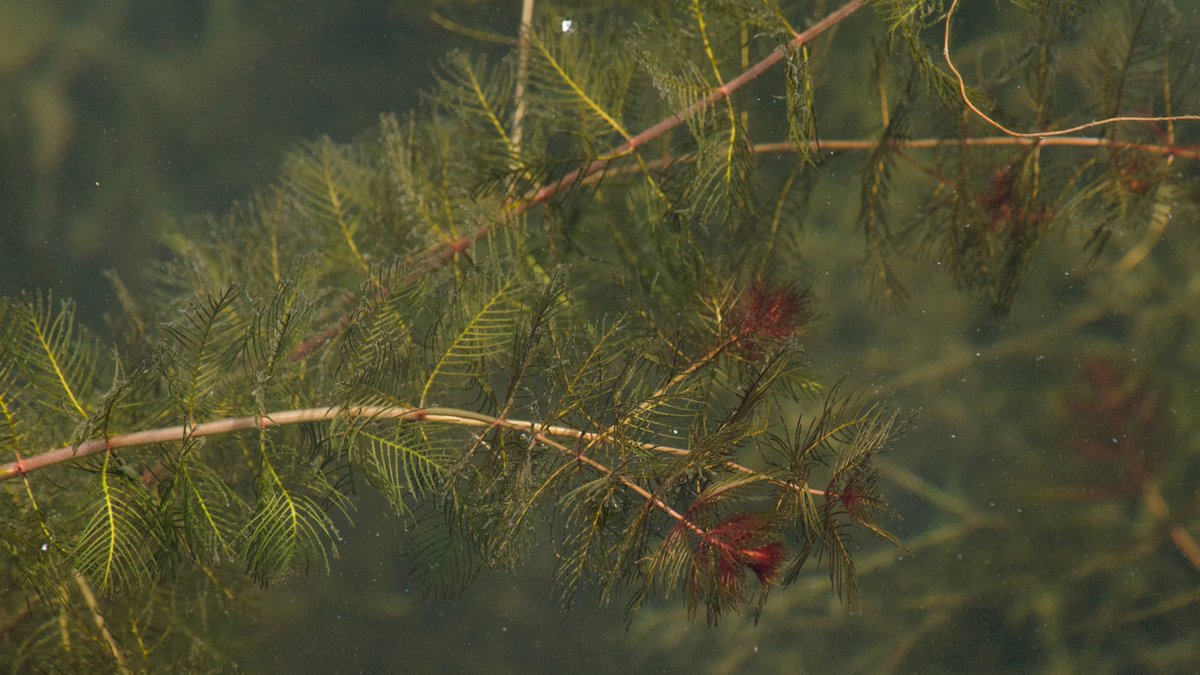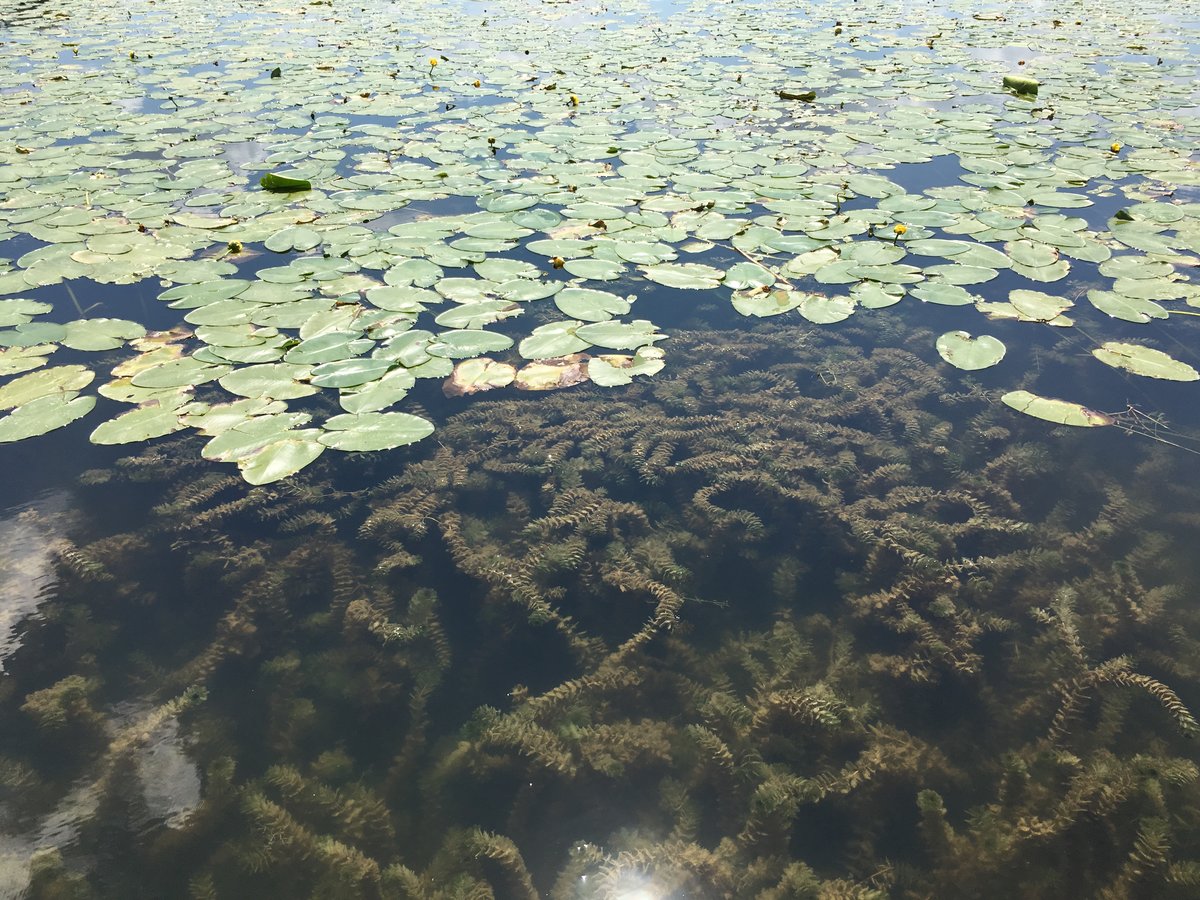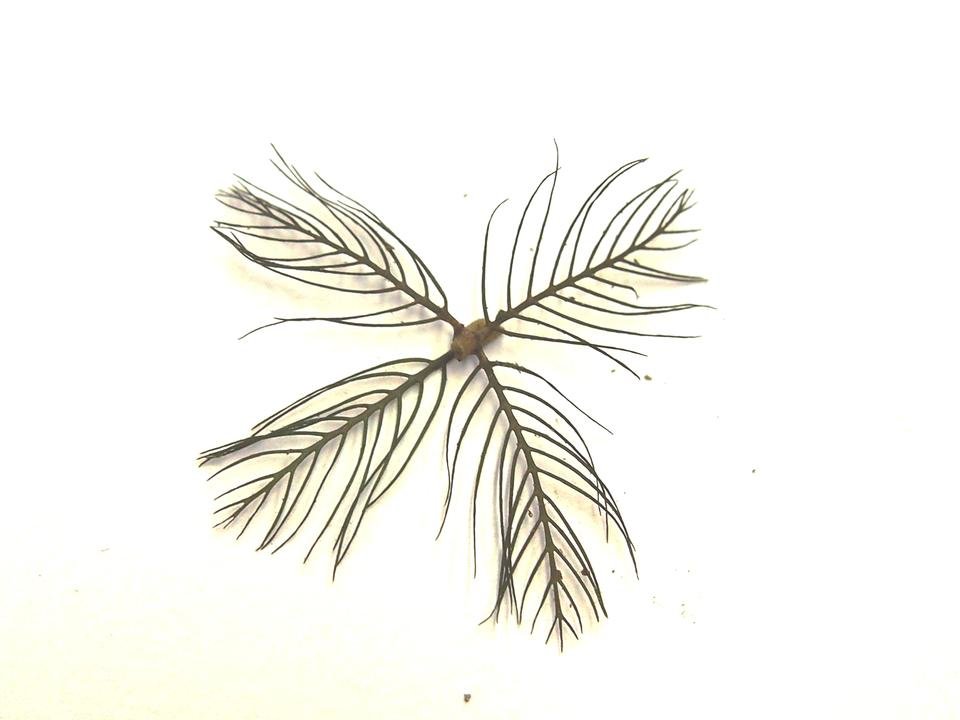Myriophyllum spicatum L. (Eurasian watermilfoil ) and Myriophyllum spicatum x Myriophyllum sibiricum (Hybrid watermilfoil)
Eurasian watermilfoil (Myriophyllum spicatum L.) is an invasive aquatic plant that was introduced to North America in 1880 in New York state. It grows rapidly and tends to form a dense canopy on the water surface, which often interferes with recreation, inhibits water flow, and impedes navigation. Eurasian watermilfoil is a particularly problematic aquatic weed, due to its ability to reproduce from fragments and spread rapidly, its high growth rate in a range of temperatures and environmental conditions, and its tendency to reach the surface and form extensive mats of plant at the surface, which can allow it to shade and outcompete native vegetation. More about Eurasian and hybrid watermilfoil.
MAISRC Findings
- Found evidence of hybrid vigor and competitive advantage in hybrid watermilfoil, and sampled lakes around the state to genetically identify hybrid milfoil populations
- Developed and evaluated techniques to selectively control Eurasian and hybrid watermilfoil using native milfoil weevils
- Conducted enclosure and mesocosm experiments, as well as lake surveys, to assess the effect of sunfish predation on milfoil weevil densities and watermilfoil abundance to inform biocontrol strategies
- Determined that weevil populations are too low to control watermilfoil in many Minnesota lakes and that other factors, in addition to sunfish predation, are limiting populations
- Determined performance and fecundity of milfoil weevils on native, hybrid and Eurasian watermilfoil and in relation to host plant chemistry and quality
- Identified hotspots for Eurasian watermilfoil based on environmental variables and potential pathways of spread
Research
Building a Centralized Database of Watermilfoil Strain Geographic Distribution and Herbicide Response for Use in Management Decision-Making
In Michigan, researchers have discovered different types of watermilfoil plants that are more invasive or resistant to specific herbicides. Recent studies have started to explore how these strains in Michigan respond to herbicides. However, less is known about the strains in Wisconsin or Minnesota. Recent surveys and assessments in Minnesota have identified strains that should be examined for their response to herbicides. This project aims to expand the understanding of how Minnesota strains of watermilfoil respond to herbicides.
Led by Dr. Ray Newman
Will property values cool as AIS heat up?
This project will evaluate the economic impacts of Eurasian watermilfoil on property values as well as quantify the role of water temperature and other lake characteristics in determining Eurasian watermilfoil abundance.
Led by Dr. Gretchen Hansen
Eurasian and hybrid watermilfoil genotype distribution in Minnesota
This project seeks to understanding the genetic distribution of Eurasian and hybrid watermilfoil within and among Minnesota lakes and differences in response to management.
Led by Dr. Raymond Newman
Risk assessment, control, and restoration research on aquatic invasive plant species
This project will evaluate the ability of invasive aquatic plant control efforts to yield recovery of native aquatic plant communities.
Led by Dr. Daniel Larkin
Managing for sustainable native macrophyte communities in lakes of the Riley-Purgatory Bluff Creek Watershed District
This project picks up previous lines of research on removing common carp and restoring the native plant community in the Riley-Purgatory Bluff Creek Watershed District.
Led by Dr. Raymond Newman
More about Eurasian and hybrid watermilfoil
Description
Eurasian watermilfoil forms dense underwater stands of stems and mats of vegetation at the surface of the water. Mature plants have narrow flower spikes that emerge 2-5" above the water surface. Eurasian and native, northern watermilfoil hybridize to form hybrid watermilfoil. This hybrid watermilfoil is also considered invasive and is now found in a number of lakes in North America, including Minnesota.
Keys to ID:
- Compare the typical number of pairs of leaflets on a leaf
- Eurasian watermilfoil: 12-21
- Northern watermilfoil: 5-9
- Hybrid watermilfoil leaf: 8-12
Life cycle
Eurasian and hybrid watermilfoil and reproduce from fragments and seeds. Although reproduction from seeds was thought to be uncommon, the presence of hybrids and viable seeds suggests that sexual reproduction can be important. Plants flower once they grow to the surface in June-September; the emergent flower spikes give the plant its scientific name (M. spicatum). The plant will also produce autofragments in the summer; small branches that break off the plant and form roots which can establish new plants. Any fragment of the plant stem that includes a node (whorl of leaves) can produce a new viable plant. Watermilfoil stores carbohydrates in the lower stems and root crowns which enables the plant to survive over the winter, even with low or no light under the ice. In the spring when water temperatures approach 10-15 ˚C (50-60 ˚F) the plant will begin growing out of the rootcrowns and sometimes overwintering stems and grow toward the surface. The plants often form a canopy throughout the summer that shades out native plants.
Impacts
Eurasian and hybrid watermilfoil grow rapidly and tend to form a dense canopy on the water surface, which often interferes with recreation, inhibits water flow, and impedes navigation. Both are particularly problematic aquatic weeds, due to their ability to reproduce from fragments and spread rapidly, their high growth rate in a range of temperatures and environmental conditions, and their tendency to reach the surface and form extensive mats of plant at the surface, which can allow it to shade and outcompete native vegetation. Some genotypes of specifically hybrid watermilfoil are more tolerant of some herbicides and, thus, more difficult to control.
Distribution
View a map of the current distribution of Eurasian, hybrid (invasives), and northern (native) watermilfoil.
How it spreads
Eurasian watermilfoil is spread most commonly by inadvertent transport by boaters, however some waterbodies appear to have been infested by natural means (downstream transport). Milfoil can get tangled in boat propellers or become lodged in other areas of the boat or trailer. The most important thing you can do to prevent its spread is to always clean, drain, dispose, and dry your boat between lakes. If a waterbody has both Eurasian and northern milfoil present, they may produce hybrid watermilfoil offspring.
Management and control
As with most weeds, there are three general control strategies that can be employed: mechanical/manual, chemical, and biological.
- Mechanical and manual control, either by hand pulling, raking, or harvesting, is effective at reducing current abundance of plants and is useful to clear channels or maintain access.
- Chemical control can be effective, however, long-term eradication of larger infestations is unlikely and chemical controls can be expensive.
- Biological control (biocontrol) is the use of parasitoid, predator, pathogen, antagonist or competitor populations to suppress a pest population.
Milfoil weevils
The milfoil weevil (Euhrychiopsis lecontei) is a small, herbivorous aquatic beetle, that is native to North America. It is a watermilfoil (Myriophyllum spp.) specialist, meaning that it feeds and develops only on plants in this genus. The weevil completes all life stages fully submersed, feeding and developing on milfoil, and the larvae are stem miners. These characteristics make it unique—as specialist herbivores are very rare among aquatic insects. These characteristics are why the milfoil weevil has shown the most promise as a potential biocontrol agent for Eurasian watermilfoil and why it has been the subject of much research.
Learn more about milfoil weevils, where they're found, and their potential biocontrol uses



